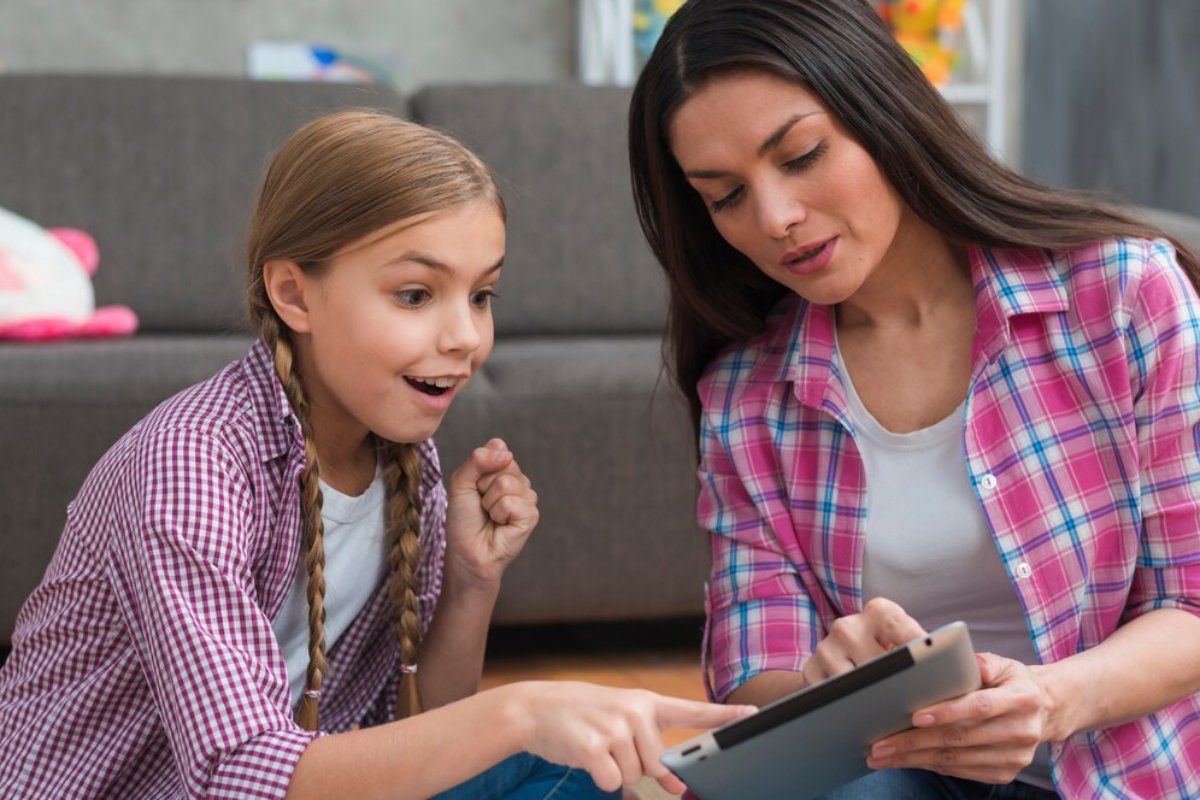
Teaching Kids to Identify Ads and Clickbait: A Guide to Media Literacy
In our digital world, kids see a lot of information from a young age. Parents and educators must help kids learn the skills they need to explore this world safely and wisely. A key part of this education is helping kids spot ads and clickbait. This builds their media literacy and awareness of digital advertising. But how exactly can we achieve this?
Media literacy is crucial for kids. It helps them understand ads and clickbait. Here are some practical ways to teach them:
- Discuss different types of media.
- Show examples of ads and clickbait.
- Encourage critical thinking about what they see.
- Use fun activities or games to reinforce lessons.
By teaching these skills, we prepare kids to navigate media wisely.
Media literacy helps kids understand not only what they watch but also why it was made. Kids must learn to question, reflect, and think critically. Today’s algorithms focus on engagement rather than accuracy. This skill set is vital. It helps raise informed people and responsible digital citizens.
Why Media Literacy Matters
Media literacy is the ability to access, analyse, evaluate, and create media in various forms. It helps people see how media shapes society and learn to think critically about the many messages they face every day. Media literacy is crucial for children. It helps them safely navigate the digital world, make informed choices, and avoid misleading information and ads.
Understanding digital advertising and clickbait awareness is a fundamental component of media literacy. Digital advertising comes in many forms. Its goal is to attract attention and sway behaviour. This often makes it hard to tell content from advertising. Clickbait uses eye-catching headlines or images to draw users in. However, it usually fails to deliver what it promises. Teaching kids to spot these tactics helps them make wise choices online.
Kids now see ads on social media, YouTube, and mobile games. These ads often look like entertainment. Teaching kids to understand these marketing tricks helps them protect themselves and think critically about persuasive messages.
Key Benefits of Teaching Kids to Identify Ads and Clickbait
Fostering Critical Thinking
Teaching kids to spot ads and clickbait helps them build critical thinking skills. When kids ask why media messages are out there, they get better at collecting information. This approach goes beyond digital media. It shapes how people understand news, advertising, and social interactions.
Encouraging kids to ask “Who created this?” and “What do they want me to think or do?” helps build the habit of mindful media consumption. These questions serve as mental checkpoints that prompt reflection before action.
Enhancing Online Safety
Children who can identify ads and clickbait are better equipped to navigate the internet safely. They are less likely to get scammed, fall for phishing, or see bad content. They can find safer choices online by recognising signs of misleading or harmful content. This helps protect their personal information and well-being.
Online safety also means stopping misinformation, which often appears as clickbait to attract more shares. Teaching kids to check sources and question viral content is key to their digital health.
Encouraging Informed Decision-Making
Media literacy encourages children to make informed decisions about the content they consume. By learning the tricks of digital ads and clickbait, they can judge whether the information is reliable and useful. This skill is invaluable in an era of information overload.
Informed decision-making means knowing when an offer seems too good to be true. It also means finding content that tries to create an emotional reaction rather than just sharing balanced facts.

Promoting Healthy Media Consumption
Teaching kids to identify ads and clickbait also promotes healthy media consumption habits. When kids learn the tricks to get attention, they can skip mindless scrolling and not overconsume. They learn to find enriching, educational content that matches their interests.
Media literacy fosters intentionality in digital interactions. Kids who grasp these ideas are better at setting boundaries. They pick quality over quantity and balance screen time with real-life activities.
Additional Expert Tips & Common Mistakes to Avoid
Start Early and Build Gradually
Start teaching media literacy to children early. Then, expand these lessons as they grow. Begin with introductory talks about ads and their purpose. Then, move on to more complex ideas like clickbait and digital advertising strategies.
Reinforce these lessons through daily interactions. Watching videos or reviewing websites together can teach kids. Use language and examples that fit their age.
Use Real-Life Examples
Utilise real-life examples to illustrate the concepts of ads and clickbait. Show children examples of advertisements and discuss the techniques used to capture attention. Similarly, explore examples of clickbait headlines and analyse why they might be misleading.
Discuss how thumbnails, headlines, and influencer endorsements shape opinions and drive behaviour. Encourage children to spot and decode these tactics in their own media use.
Encourage Open Dialogue
Create an environment where children feel comfortable discussing media messages they encounter. Invite them to ask questions and share their thoughts on the content. This open dialogue fosters a deeper understanding and reinforces critical thinking skills.
Be patient and non-judgmental when children share their views. Use their experiences as teaching moments rather than opportunities for correction.
Avoid Overloading with Information
It’s crucial to teach kids about media literacy. But be careful not to give them too much information at once. Focus on one concept at a time and ensure they fully understand it before moving on to the next.
Keep lessons interactive and allow ample space for questions, exploration, and follow-up. Repetition and reinforcement through varied formats—videos, games, stories—will support long-term retention.
Advanced Insights and Expert Recommendations
Integrate Media Literacy into the Curriculum
For educators, weaving media literacy into the curriculum is a game-changer. This vital education helps all children navigate today’s digital landscape. Consider blending lessons on digital advertising with English, social studies, or art. Transform these subjects into engaging experiences that resonate with students. Cultivating awareness of clickbait equips young minds for the media-saturated world. Let’s make learning dynamic, relevant, and impactful!
Media analysis exercises can be a launchpad for learning. Comparing headlines and dissecting commercials sparks curiosity and critical thinking. Encourage students to craft their messages, infused with ethics. This hands-on activity helps them understand better. It also builds a solid base for responsible communication.
Utilise Digital Tools and Resources
Leverage digital tools and resources designed to teach media literacy. Many online platforms and educational games provide fun lessons on spotting ads and clickbait. These tools make learning fun and accessible for children of all ages.
Look for resources from reputable organisations such as Common Sense Media or MediaSmarts. These platforms offer lesson plans, videos, and games for various age groups.

Collaborate with Parents and Guardians
Collaboration between educators and parents is key to reinforcing media literacy education. Encourage parents to keep talking at home. Provide them with tools and tips for effectively discussing media messages with their kids.
Host workshops, send newsletters, or offer take-home materials that empower families to participate in media education. Creating a unified message across school and home strengthens the child’s learning.
Stay Informed About Emerging Trends
The digital landscape is a wild playground, ever-shifting and ever-surprising. New advertising wonders and clickbait antics pop up like mushrooms after rain. Staying in tune with these trends is essential for your media literacy toolkit. This continuous learning ensures your guidance stays sharp and effective for the kids.
Tap into the wisdom of media literacy pioneers and stay updated on digital safety. Dive into professional development to enhance your expertise. Inspire your students and children to voice their observations, turning them into co-researchers in the ever-evolving media landscape. Together, let’s navigate the waves of information!
Conclusion: Empowering the Next Generation
Guiding kids to spot ads and clickbait is vital for media literacy. By nurturing critical thinking, we fortify online safety and informed choices. This empowers the next generation to navigate the digital realm with confidence. As parents, educators, and community members, we hold the charge. It’s our duty to equip children with essential skills to flourish in a complex media terrain. Let’s step up today! Together, we can ensure our children aren’t just media consumers but savvy creators shaping tomorrow’s landscape.
In conclusion, the journey to media literacy is ongoing, requiring commitment and collaboration from all stakeholders. By prioritising this education, we lay the foundation for a future where children are not only aware of the media’s influence but also capable of using it to their advantage. Let’s embrace this challenge and work together to create a media-literate generation ready to tackle the digital world with confidence and discernment.


